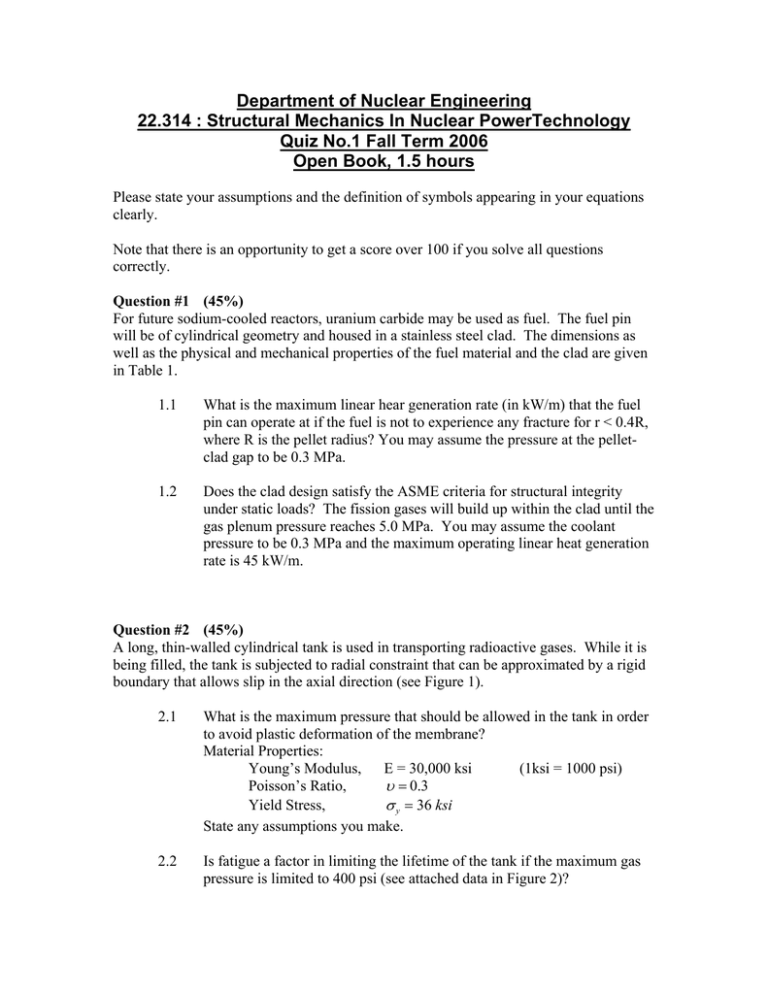Department of Nuclear Engineering 22.314 Quiz No.1 Fall Term 2006
advertisement

Department of Nuclear Engineering 22.314 : Structural Mechanics In Nuclear PowerTechnology Quiz No.1 Fall Term 2006 Open Book, 1.5 hours Please state your assumptions and the definition of symbols appearing in your equations clearly. Note that there is an opportunity to get a score over 100 if you solve all questions correctly. Question #1 (45%) For future sodium-cooled reactors, uranium carbide may be used as fuel. The fuel pin will be of cylindrical geometry and housed in a stainless steel clad. The dimensions as well as the physical and mechanical properties of the fuel material and the clad are given in Table 1. 1.1 What is the maximum linear hear generation rate (in kW/m) that the fuel pin can operate at if the fuel is not to experience any fracture for r < 0.4R, where R is the pellet radius? You may assume the pressure at the pelletclad gap to be 0.3 MPa. 1.2 Does the clad design satisfy the ASME criteria for structural integrity under static loads? The fission gases will build up within the clad until the gas plenum pressure reaches 5.0 MPa. You may assume the coolant pressure to be 0.3 MPa and the maximum operating linear heat generation rate is 45 kW/m. Question #2 (45%) A long, thin-walled cylindrical tank is used in transporting radioactive gases. While it is being filled, the tank is subjected to radial constraint that can be approximated by a rigid boundary that allows slip in the axial direction (see Figure 1). 2.1 What is the maximum pressure that should be allowed in the tank in order to avoid plastic deformation of the membrane? Material Properties: Young’s Modulus, E = 30,000 ksi (1ksi = 1000 psi) Poisson’s Ratio, υ = 0.3 Yield Stress, σ y = 36 ksi State any assumptions you make. 2.2 Is fatigue a factor in limiting the lifetime of the tank if the maximum gas pressure is limited to 400 psi (see attached data in Figure 2)? Consider the utilization factor suggested by Soderberg for cyclical loading: σm σa + ≤1 σy σN Where σ m is the mean stress during a cycle, σ y is the yield stress, σ a is the alternating stress, and σ N is the stress intensity causing failure after 105 cycles. Table 1 Fuel Pellet Radius = 20mm Clad Inner Radius = 21mm Clad Outer Radius = 23mm Active Fuel Height = 1.5m Young’s Modulus E (GPa) Poisson’s Ratio υ Fracture Strength σf (MPa) Yield Strength σy ( MPa) Thermal Conductivity k (W / m°C) Thermal Expansion Coefficient α (µm /mC) UO2 200 0.32 150 3 10 UC 210 0.30 300 20 10 Steel 70 0.30 330 20 16 Figure by MIT OCW. Question #3 (20%) Consider a beam as shown in Figure 3, subjected to an axial force, F2 and a lateral force, F1. Evaluate the value of F2 that will lead to a “ limit load “ condition for elastic behavior of the beam when F1 = 8 MN. Steel Data: Young’s Modulus, Poisson’s Ratio, Yield Stress, E = 191 GPa υ = 0.28 Sy = 345 MPa Figure by MIT OCW.






